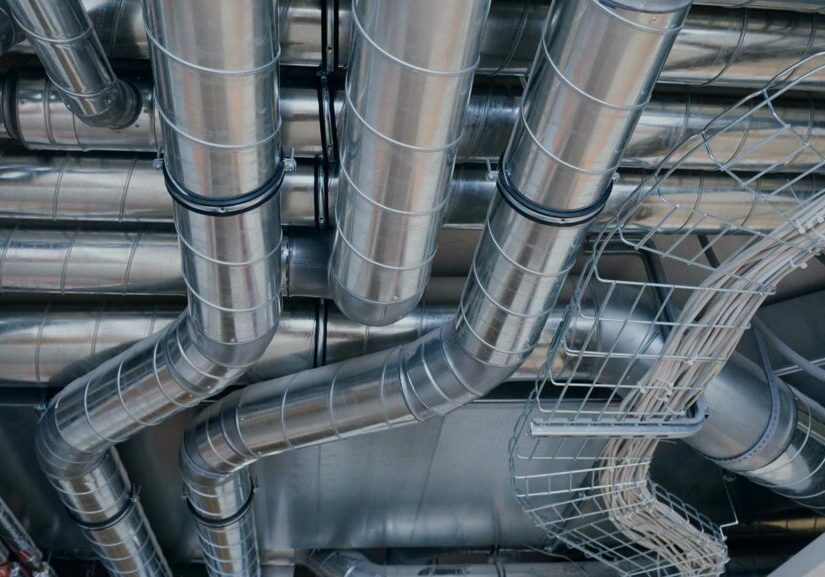Indoor air quality (IAQ) is one of the most important determinants of the health of staff and students. Poor IAQ may include temperature and humidity extremes; airborne contaminants, such as mold and toxic chemicals; and inadequate outside air. Poor IAQ creates a poor learning environment and is associated with headaches, drowsiness, skin rashes, dry and itchy eyes, stuffy or runny nose, respiratory problems such as asthma, and many other symptoms.
The purposes of a ventilation system are to distribute adequate, clean outdoor air, to control temperature and relative humidity, and to remove odors and contaminants by filtration and dilution. But a poorly designed or poorly maintained ventilation system may fail in any of those functions and contribute to poor air quality.
To successfully advocate for better IAQ, some basic knowledge of heating, ventilation, and air conditioning (HVAC) systems is helpful.
Types of ventilation systems
Some buildings have a central HVAC system for the whole building or for a wing (see diagram at left). Other buildings may have unit ventilators, each serving one room. Some buildings have natural ventilation, utilizing windows for outdoor air and exhaust or utilizing a hall exhaust fan that may serve a whole corridor of rooms. Many schools have a combination of two or more types of systems.
HVAC systems
Below are the main elements of an HVAC system and some key concerns with each one:
- Overall system design should keep occupied areas at positive pressure (meaning higher than neighboring areas) so that outside air doesn’t infiltrate through cracks, window edges, and other routes.
- Outside air intakes should not be located near contaminant sources, such as idling vehicles, pesticide use areas, or on the roof near exhaust from kitchens, bathrooms, or other sources.
- Filters should be replaced on schedule.
- Heating and cooling elements should be adequate to provide appropriate air temperature.
- A supply fan and ducts distribute air to occupied areas. There can be many reasons why sufficient air does not get supplied to every area of the building: dampers within ducts may be closed or stuck; open windows or closed doors alter the pressurization of different rooms, affecting air distribution.
- An exhaust or return fan sends room air to a mixing chamber. Possible reasons for insufficient exhaust are inoperable dampers; obstructed, leaky or disconnected ductwork; undersized or improperly installed fans; and broken fan belts.
- A mixing chamber combines outside air with return air. When energy was cheap, 100 percent outside air could be used, but heating and cooling costs now make that prohibitively expensive. Now it is necessary to ensure that the mix contains adequate outside air to dilute contaminants. Dampers control the proportion of outside air and return air in the mix. They must be functioning and set to bring in adequate outside air, though in many school systems, they are in fixed positions.
Unit Ventilator Systems
A unit ventilator consists of a baseboard, ceiling, or above-ceiling box running along an outside wall. It takes in outside air and room air, mixes them, heats them in winter, and blows the mixture into the room. Problems with unit ventilators include:
Outside air intake is not open sufficiently, or located near outside contaminant sources (see HVAC section).
Dirty or moldy elements in the unit, such as dampers or heating elements.
Blocked supply or return louvers by objects placed on or in front of the unit.
What local associations can do
Initiate the 10-step process provided in the NJEA booklet, Organizing for Better Indoor Air Quality : It includes the key starting point, forming a Health and Safety Committee, as well as committee tasks, such as researching and documenting problems, educating staff, and various problem-solving steps. Consult your UniServ field representative to help you organize a committee.
Demand HVAC operation and maintenance: The 2007 New Jersey Indoor Air Quality Standard (see sidebar) requires the district to replace or repair damaged or inoperable components and to establish and follow a preventive maintenance schedule to check, lubricate, and ensure that all HVAC components are in operating order. In some newer buildings, the system may be operated by computerized controls. Whatever the system, maintenance staff should be trained in system operation and maintenance.
File PEOSH complaints on violations of the IAQ Standard when necessary: Visit www.state. nj.us/health/peosh/index.shtml or call 609-984-1863 for more information. Share with members probes they can do themselves, including:
- Check for air movement at a ceiling or wall diffuser (air inlet). Attach a piece of tissue or ribbon to a yard stick and hold it in front of the diffuser. If it flutters there is air flow.
- Check that rooms are at positive pressure by opening the door a little, then holding the tissue or ribbon in front of the opening. If it blows out, the room is at positive pressure.
- Check that potential sources of air contaminants inside the school are ventilated directly to the outside. Sources may include copiers and printers, art rooms and labs, cafeterias, locker rooms and showers.
- Log temperatures using a thermometer.
For more information
The ventilation system is a key determinant of indoor air quality, but not the only one. For a thorough discussion of taking action on IAQ, see sidebar for Health and Safety Index
Tools for Schools, from the Environmental Protection Agency, has a variety of excellent materials for school staff to conduct their own IAQ assessments and actions. For HVAC systems in particular, check:
- Ventilation System Checklist www. epa.gov/iaq/schools/actionkit.html.
- Background information for above checklist can be found at www.epa. gov/iaq/schools/pdfs/kit/checklists/ventchklstbkgd.pdf.
The PEOSH IAQ standard site has many resources besides the standard itself, including a model IAQ program and several pamphlets on school hazards.
